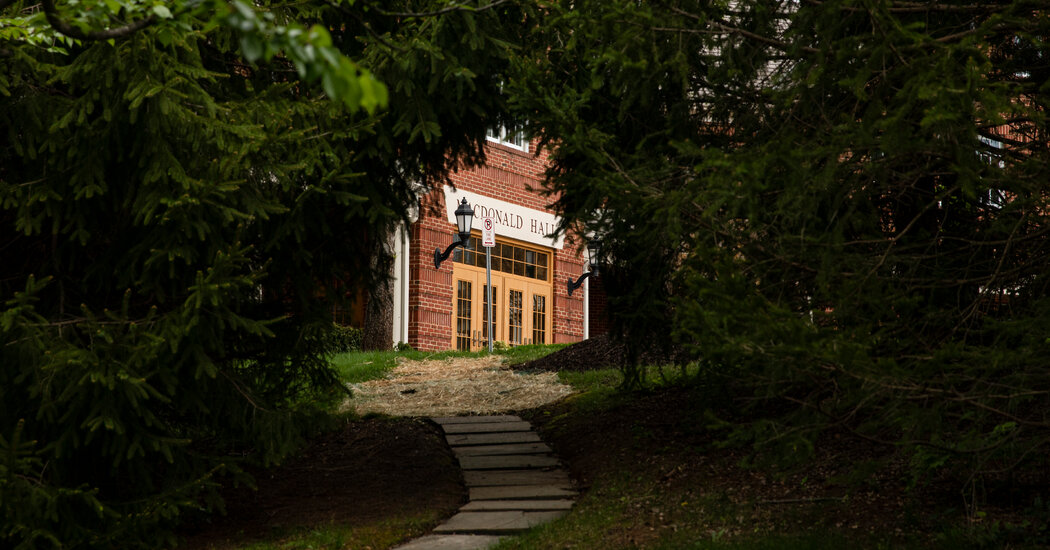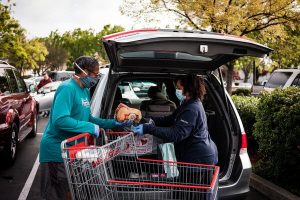WASHINGTON — The school attended by President Trump’s son will not fully reopen in September out of concern over the coronavirus pandemic despite the president’s insistence that students across the country be brought back to classrooms in the fall.
St. Andrew’s Episcopal School, a private school in Washington’s Maryland suburbs, said in a letter to parents that it was still deciding whether to adopt a hybrid model for the fall that would allow limited in-person education or to resume holding all classes completely online as was done in the spring. The school will decide early next month which option to follow.
“We are hopeful that public health conditions will support our implementation of the hybrid model in the fall,” said the letter signed by Robert Kosasky, the head of school, and David Brown, the assistant head. “As we prepare to make a decision the week of Aug. 10 about how to best begin the school year,” they added, “we will continue to follow guidance of appropriate health officials and refine both our hybrid and distance learning plans.”
If the school does opt for the hybrid model, students in Grades 7 through 12 would rotate between on-campus and distance learning, with half of the students learning remotely each week. Barron Trump, 14, the youngest of the president’s five children, has spent the last three years at St. Andrew’s.
Mr. Trump has repeatedly insisted that schools fully open and has threatened to withhold federal money from districts that do not, but states, localities and private schools increasingly are defying him.
Teachers’ union leaders said the St. Andrew’s situation should bring home to Mr. Trump how complicated reopening is for schools trying to balance the educational needs of their children and the health concerns of the staff, students and community.
“The president now has to face what every other parent in America and every other teacher in America is grappling with right now, which is: In the midst of a pandemic, how do schools keep their kids and their faculty safe?” Randi Weingarten, the president of the American Federation of Teachers, said in an interview. “It’s about safety, not bluster. It’s about a plan and resources, not threats.”
Ms. Weingarten said Mr. Trump’s confrontational approach had made it harder to find practical solutions to a problem everyone wants fixed. “Hopefully, Donald Trump will have a scintilla of empathy and consideration for what Americans are going through now that he is experiencing it himself,” she said.
The Milton Gottesman Jewish Day School of the Nation’s Capital, where Ivanka Trump, the president’s oldest child, and her husband, Jared Kushner, send their children, has not decided whether or how to reopen in the fall.
At a coronavirus briefing on Wednesday, Mr. Trump expressed no qualms about Barron or his school-age grandchildren returning to class. “I am comfortable with that,” he said.
The Coronavirus Outbreak ›
Frequently Asked Questions
Updated July 23, 2020
-
What is school going to look like in September?
- It is unlikely that many schools will return to a normal schedule this fall, requiring the grind of online learning, makeshift child care and stunted workdays to continue. California’s two largest public school districts — Los Angeles and San Diego — said on July 13, that instruction will be remote-only in the fall, citing concerns that surging coronavirus infections in their areas pose too dire a risk for students and teachers. Together, the two districts enroll some 825,000 students. They are the largest in the country so far to abandon plans for even a partial physical return to classrooms when they reopen in August. For other districts, the solution won’t be an all-or-nothing approach. Many systems, including the nation’s largest, New York City, are devising hybrid plans that involve spending some days in classrooms and other days online. There’s no national policy on this yet, so check with your municipal school system regularly to see what is happening in your community.
-
Is the coronavirus airborne?
- The coronavirus can stay aloft for hours in tiny droplets in stagnant air, infecting people as they inhale, mounting scientific evidence suggests. This risk is highest in crowded indoor spaces with poor ventilation, and may help explain super-spreading events reported in meatpacking plants, churches and restaurants. It’s unclear how often the virus is spread via these tiny droplets, or aerosols, compared with larger droplets that are expelled when a sick person coughs or sneezes, or transmitted through contact with contaminated surfaces, said Linsey Marr, an aerosol expert at Virginia Tech. Aerosols are released even when a person without symptoms exhales, talks or sings, according to Dr. Marr and more than 200 other experts, who have outlined the evidence in an open letter to the World Health Organization.
-
What are the symptoms of coronavirus?
- Common symptoms include fever, a dry cough, fatigue and difficulty breathing or shortness of breath. Some of these symptoms overlap with those of the flu, making detection difficult, but runny noses and stuffy sinuses are less common. The C.D.C. has also added chills, muscle pain, sore throat, headache and a new loss of the sense of taste or smell as symptoms to look out for. Most people fall ill five to seven days after exposure, but symptoms may appear in as few as two days or as many as 14 days.
-
What’s the best material for a mask?
- Scientists around the country have tried to identify everyday materials that do a good job of filtering microscopic particles. In recent tests, HEPA furnace filters scored high, as did vacuum cleaner bags, fabric similar to flannel pajamas and those of 600-count pillowcases. Other materials tested included layered coffee filters and scarves and bandannas. These scored lower, but still captured a small percentage of particles.
-
Does asymptomatic transmission of Covid-19 happen?
- So far, the evidence seems to show it does. A widely cited paper published in April suggests that people are most infectious about two days before the onset of coronavirus symptoms and estimated that 44 percent of new infections were a result of transmission from people who were not yet showing symptoms. Recently, a top expert at the World Health Organization stated that transmission of the coronavirus by people who did not have symptoms was “very rare,” but she later walked back that statement.
The White House had no comment on Thursday on the decision by St. Andrew’s, but at a briefing later in the day, Mr. Trump seemed more flexible in demanding reopenings, acknowledging the need to take safety measures more than he has in the past.
In areas with surging infections, he said, reading from a script, “districts may need to delay reopening for a few weeks.”
“That’s possible,” he said. “That’ll be up to governors. The decisions should be made based on the data and the facts on the ground.”
But he emphasized the need to reopen quickly. “We cannot indefinitely stop 50 million American children from going to school, harming their mental, physical and emotional development,” he said. “Reopening our schools is also critical to ensuring that parents can go to work and provide for their families.”



















